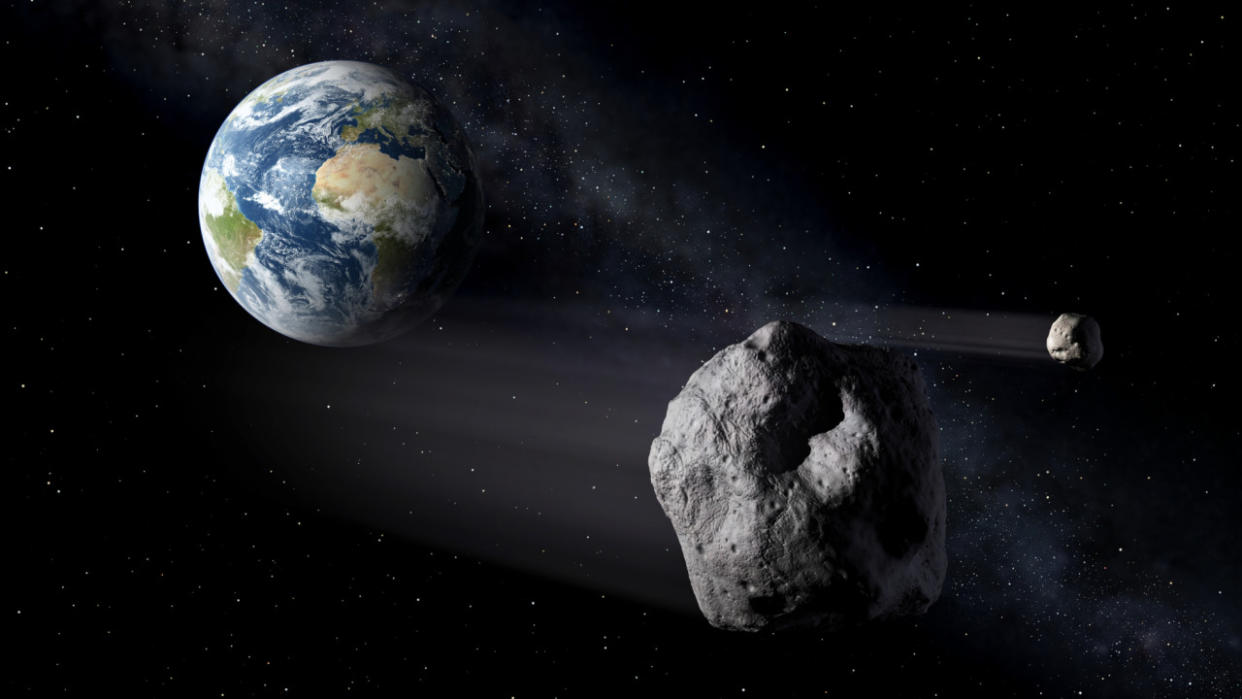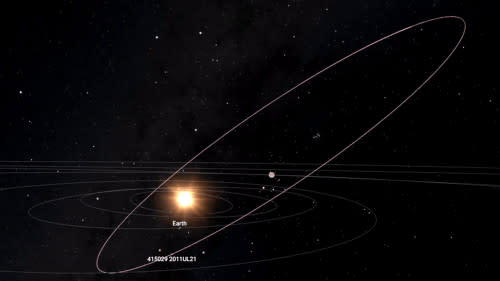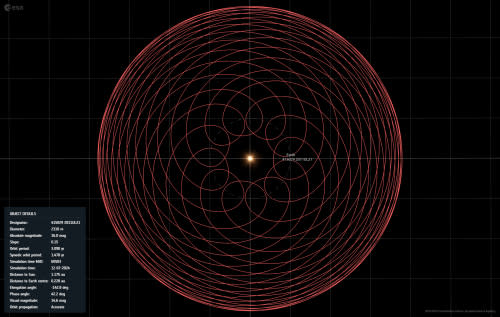Two massive asteroids swing past Earth this week, but don't worry! We're safe!

Just in time for Asteroid Day 2024, two massive asteroids are making close flybys past Earth this week. Although both encounters will pass without any danger to us, they are an excellent example of why we need to find all asteroids that may pose a threat to Earth.
Around 4 p.m. EDT on Thursday, June 27, 2024, one of the largest near-Earth asteroids we've ever found will be passing by our planet.
415029 (2011 UL21), as this asteroid is known, was discovered in October 2011 by the Catalina Sky Survey, a program run by the Steward Observatory to find near-Earth objects. According to the European Space Agency, at around 2.3 kilometres wide, asteroid 415029 (2011 UL21) is larger than 99 per cent of all near-Earth objects on record.
With its immense size, and travelling through space at over 25 kilometres per second (90,000 km/h), this asteroid would be considered a 'planet killer' if it ever struck Earth. Fortunately, although this is the closest flyby on record so far for 415029 (2011 UL21), it actually poses no threat to us.

This infographic contains all the important details for asteroid 415029 (2011 UL21), including that it poses a zero per cent chance of impacting Earth. (ESA)
Thursday's encounter is certainly a 'close shave' by astronomical standards. However, even at its absolute closest approach it will still be over 6.6 million kilometres away. That's more than 17 times farther than the Moon!
So, there's nothing to worry about from this massive space rock, but it certainly is an odd one.

(415029) 2011 UL21's oddly inclined orbit is shown here compared to the planets of the inner solar system. (ESA)
"This asteroid's orbit around the Sun is steeply inclined, which is unusual for such a large object. Most large objects in the Solar System, including planets and asteroids, orbit the Sun in or close to the equatorial plane," says the ESA.
"This could be the result of gravitational interactions with a large planet like Jupiter. Jupiter can deflect previously safe asteroids inwards towards Earth, so understanding this process is important."
Additionally, the shape of this asteroid's orbit around the Sun puts it into a regular recurring pattern with Earth's orbit, known as a resonance.
"(415029) 2011 UL21 is in an '11:34 resonance' with Earth. It completes 11 orbits about the Sun in almost the exact same amount of time in which Earth completes 34 orbits (i.e. 34 years)," the ESA explained. "The result is a pleasant repeating pattern when you visualize the asteroid's location relative to Earth over a period of 34 years while keeping Earth fixed in place."

This 'spirographic' pattern results from keeping Earth fixed in one spot relative to the Sun and tracing out the asteroid's orbit over a full 34 year resonance period. (ESA)
DON'T MISS: A 'new star' may be just weeks from appearing in the northern sky
Discovered just days ago
Less than two days later, a second large asteroid is sweeping past Earth.
At around 9:45 a.m. EDT on Saturday, June 29, newly discovered '2024 MK' will make its closest approach ever to our planet.

All the relevant information on asteroid 2024 MK is shown in this infographic, which includes its zero per cent chance of impacting Earth. (ESA)
Discovered less than two weeks before this encounter, 2024 MK is significantly smaller than 415029 (2011 UL21), at between 120 and 260 metres wide. At the same time, though, it comes significantly closer to Earth. At closest approach, it will be only around 290,000 kilometres away, or roughly 75 per cent of the distance to the Moon.
"There is no risk of 2024 MK impacting Earth," says the ESA. "However, an asteroid this size would cause considerable damage if it did."
Little is known about this space rock beyond a fairly decent approximation of its orbit. However, astronomers are planning on observing it during this flyby, as well as 415029 (2011 UL21), by bouncing radio waves off of them to gather a radar picture of their size and shape.
Celebrate Asteroid Day
On June 30, 1908, a small asteroid exploded in Earth's atmosphere above the Tunguska region of Siberia. Tens of millions of trees were levelled across over two thousand square kilometres of the surrounding wilderness. Although no remnants of the object have ever been found, it was the most significant asteroid impact event of the modern era.
For the past eight years, each June 30 has been designated as 'Asteroid Day' — a day to promote public awareness about the risks of asteroid impacts. In addition, it has become about educating people regarding the important role these objects played in the formation of Earth and the solar system, as well as the role they may play in human history going forward.
Not only do we need to dedicate more effort and resources to finding all asteroids that my threaten Earth, we also need to discover more ways of protecting ourselves from those that do pose a danger. NASA's DART mission is currently the only successful demonstration we have of an asteroid mitigation plan.
As our methods of space exploration become more sophisticated, though, asteroids may become a new resource for the future, as we capture and mine them for the metals and minerals contained within.
Asteroid Day activities are taking place on June 28 and 29 this year. Retired Canadian astronaut Julie Payette is one of the guests at the Asteroid Day Festival on June 29.
Thumbnail image is an artist's conception drawing, courtesy the ESA and P. Carril


